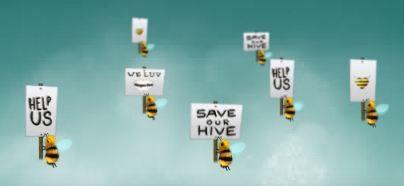“Because whales are so cute!” was the reply I heard a Greenpeace activist give when asked why she joined the environmental advocacy group. Cuteness has always been used to foster support for dire causes. Images of baby cows and pigs are a staple for animal welfare campaigns. Anti-poverty and hunger organizations feature cute, impoverished children in their television ads. Now cuteness is being used for another cause, perhaps the most important issue of the 21st century: environmentalism. Using cuteness, environmental propaganda casts nature as an innocent, helpless child in need of a guardian.

Cute animals are a fixture in environmental advocacy. News coverage of the Exxon Valdez oil spill in 1989 tugged on heartstrings by focusing on helpless seals, otters and seabirds covered in oil. Cute dolphins and whales bolstered support for responsible commercial fishing practices and dolphin-safe tuna. Images of manatees injured by boat motors promote responsible boating. The latest use of the “save the planet to save cute animals” tactic has been Haagen Daaz’s “Help the Honey Bees” campaign. Their web site illustrates the environmental harm caused by disappearing bee colonies with little honey bees holding placards with the slogans “Help us!” and “SOS”.

A host of corporations have “cute-ified” their logos, turning to natural designs to green their public image. Plants are especially popular, symbolizing the growth of new ideas and strategies. The stodgy shield logo of BP (formally British Petroleum) has bloomed into a sunny green and yellow flower, shining brightly in television commercials with whistling gas pumps urging us “to make the day a little better”. Agricultural biotech giant Monsanto has replaced its block “M” with a spry little vine. The new Greenlist labels on SC Johnson’s household cleaners also have a cute, leafy vine.
Environmental awareness has been around for decades, but increasing alarm about global warming has put it on the forefront of the public mind. It is no longer only in the realm of hippies and tree huggers; the average American consumer can also be an environmentalist! But since the issue of environmentalism is so vast and complicated, many newcomers to the green movement may feel unsure about where they can start. Cuteness is an effective way to make novel, complicated ideas and technology easier to understand by taking away uncertainty and allowing empathy. For example, when introducing the iMac G3 in 1998, Apple focused on the computer’s cuteness and ease of use rather than its technological capabilities. Television commercials playing the Rolling Stones’ “She’s a Rainbow” emphasized that the G3’s rounded, approachable design came in a variety of bright colors. Similarly, the green movement is now focusing on easy, feel-good ways consumers can help the planet.
Small, low-effort contributions that help a larger cause can be a good way to get people to care about an issue, such as Donating $0.50 a day to help an impoverished child eat and go to school. Most people are busy with their jobs and families and don’t wish to veer too much from their usual routines. Greening one’s domestic situation and consumer choices can be a good place to start. Many of the shows on the Discovery Network’s new all-environmental channel Planet Green focus on ways to do this: plant low-water use grass in your yard; buy produce from your local farmers market; install new insolated windows to reduce heating needs. You can save the planet from your own backyard.
This method of promoting environmentalism through small, homebound efforts is also popular because it works with the familiarity people have with domesticated nature. Home lawns, gardens and residential parks are seen as non-threatening portions of nature, easy to maintain and control — similar to pet dogs and cats. This familiarity and reliance on humans evokes feelings of empathy. People can relate more to nature when it’s cute little flowers and butterflies, not hurricanes or tornadoes or the avian flu.
Is it helpful to the green movement to gain attention for the cause by focusing on the cute parts of nature? It’s easy to sympathize with polar bears in danger from melting glaciers, but not necessarily the microbes or fungi that make up the majority of life on the planet- and can have a bigger impact on the environment if threatened by global warming. Cute-ifying environmentalism can help newcomers understand the movement’s goals, but it can also simplify and minimize the very real threat of environmental destruction.
While people may feel good buying a green laundry detergent with a picture of a cute tree on the bottle, it plays into the very consumerism that is causing environmental destruction. It may be a good place to start, but people then have to be educated about the effects their choices have on the environment, and what more they can do to help. It is also important to alert consumers to “greenwashing”, masking environmentally-unfriendly practices with a green public face.
Ultimately, environmentalism may benefit from cuteness. It can reduce the apprehension this large, scary issue generates, offering people a sense of hope: If we all work together, we can fix it. Just like Apple was “the computer for the rest of us”, cuteness can be used to make the most important issue of the 21st century more palatable for everyone.
Nicole Peterson is a recent graduate from the Massachusetts College of Art and Design in Boston. “A Brighter, Cuter Future” is part of her on-going research project Design Benign, studying how cuteness is used in contemporary design culture.






This is a great article! Strikes me that, similarly, preschool and daycare signs that feature colorful crayon lettering and the backward "e" does not ultimately instill faith that the school will help your child with penmanship and the alphabet.
The childish lettering on the daycare sign is meant instead to convey that the building houses a place for children...and not the quality of the services.
This could be the case with the environmental movement. To elicit sympathy and connection, people like the perennially cute Sally Struthers parade out pictures of cute kids. Sure. Over time the "cute kid" montage becomes loaded with de facto meaning.
If I see a dramatic picture of a walrus doing something powerful on the cover of a pamphlet, it's going to be about walrus "science." If I see a close-cropped picture of a baby walrus (awwww!) it's going to be about protection.
The question of whether this ultimately benefits the cause(s) is difficult for me to grasp. On one hand it seems to diminish, simplify and distort the complexity of the issue. (Imagine two cute cartoon characters where one is smacking the shit out of the other and the headline "domestic violence hurts everyone!") However, the cute quotient is the great equalizer...everyone can appreciate cute. So wouldn't that be a great place to start with a message that required mass sympathy? What else is there?
On Jul.31.2008 at 01:46 PM